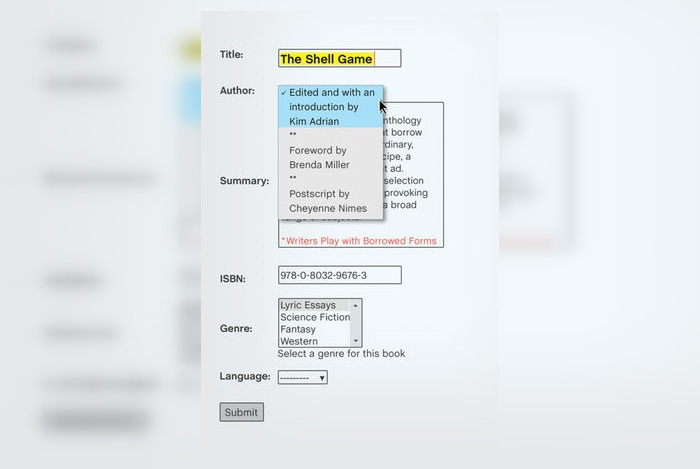When I first read Frankenstein, I was a teenager, far from questioning and reflecting upon my own possible future as a mother, or of raising a child on my own and what the implications would be. When I first read the novel, I read it for the way in which the themes of doubling felt true to my life as an identical (and mirror) twin, as a child of narcissistic parents, and a victim of a mother’s abandonment. I always read Victor Frankenstein as the abandoning mother, never as a father, for how he takes on the act of motherhood and childbirth in the birthing of his creature.
But I also read Frankenstein as an abandoned child as well, one who mourns the death of his own mother at the same time that he is fleeing her deathbed wish that he marry his betrothed, Elizabeth Lavenza, a fair-haired orphan the mother adopts. When his mother brings Elizabeth into the house, she tells five-year-old Victor to call her cousin, but later mandates she will be his beloved: “I have a pretty present for my Victor—tomorrow he shall have it.” Ironically, it is also Elizabeth that Victor blames for his mother’s death, as it is she who becomes struck with scarlet fever, and thus, his mother, in her efforts to care for Elizabeth. I sympathize for the set up that led to the narcissism of Victor Frankenstein (an over-involved, and then wholly absent, mother) but not for the reckless choices he makes with his own child, his own creation. Certainly, I connected with it as a child of narcissism myself, one in which I could appreciate the fractured childhoods that each of my parents had, but still held my own makers responsible for the neglect and abuse that stemmed from their own narcissistic wounds. My mother especially, who abandoned me in various clear and shadowy ways throughout my childhood, never could let go of that shimmery reflection of her own body in her own mythological pond, in order to properly bond with and care for me. As James Baldwin says, “If you can examine and face your life, you can discover the terms with which you are connected to other lives, and they can discover them too—the terms with which they are connected to other people.” From that early age, Frankenstein was the lens through which I sought to understand how I was made, so that I could, hopefully, break the fractured binds from which I was made by my own creators, who had not examined the ways that they were made when they made me.
The second time I read Frankenstein, I had just left the last relationship I would have with a narcissistic creative, one that also ended in the loss of a child (through abortion) and the potentiality of an equal union. The second time I read Frankenstein it was to understand the circumstances that led to my being in such a disastrous condition, and so I read the novel again to understand how the narcissism of my parents, particularly my father, and the abandonment of my mother, led me to the crossroads at which I now found myself, and hopefully, in order to gain insight into how I could extricate myself from the pattern of being the narcissist’s support. In other words, I needed to learn my own nature and past so that I could live more deliberately. I needed to look into the mythical pool of water as the Creature had, and reject the hideousness that had been projected onto me by my creators. It was through that second reading that I would ultimately birth my own creature, a collaborative dance theater adaptation exploring not only the novel, but also how Mary Shelley’s life intersected with the themes borne in and of the text itself.
I most recently re-read Frankenstein right after my wedding, when I imagined that Frankenstein and its lessons on narcissism and parental trauma would be, finally, hopefully, far behind me. It was during that blissful occasion that I came across Charlotte Gordon’s Romantic Outlaws: The Extraordinary Lives of Mary Wollstonecraft and Her Daughter Mary Shelley. Gordon answers a question many have pondered over the two centuries that Shelley’s masterpiece has been received and remade and interrogated in the public eye, in forms such as plays, films, television shows, cereal boxes, dance, scholarly papers, fan fiction, memoir, and onwards: What kind of influence did the so-called mother of Western Feminism and esteemed author of The Vindication of the Rights of Men and Women, Mary Wollstonecraft, impart on her daughter Mary Shelley?
Gordon takes up the lives of both women in chronological order, alternating chapters focusing on Wollstonecraft’s life with those of Shelley’s to prove that the mother and daughter indeed were connected beyond birth and death. (Wollstonecraft died just ten days after her daughter was born.) Not only does Gordon successively convince the reader that Shelley was influenced by Wollstonecraft’s foundational ideas on gender equality, but that Shelley’s and Wollstonecraft’s biographies—filled with similar tragedies and hardships of being a woman and mother during their times—paralleled in surprising ways as well.
It was Gordon’s ambitious text, tracing the themes of motherhood, gender, authorship, and influence, that brought me back to Frankenstein yet again, and kept me there. After devouring the hefty tome (and sending a copy of it to my therapist as well as the other maternal figures in my life), I began to write a memoir of my own, tracing my obsession with Shelley’s masterpiece, and exploring the intersections I observed not only between Shelley’s life and her opus, but also my own life with those of both Wollstonecraft and Shelley. Just as the Creature was a collage of mismatched parts from the wounds of past embodied lives, propelled into action with a spark of electricity and a madman’s dream that quickly became a nightmare, my memoir was its own monster of my creation, attempting to make something out of the past and present, out of my own words and the words of Shelley and Wollstonecraft and Gordon and even Anne Carson and Susan Sontag, allowing the intertextuality of other voices to attach to my own in order to form my own imperfect creation.
As I reflect on Gordon’s work, it is hard not to consider the particular cultural and political moment in which women now find themselves. We have, however, always found ourselves in a similar moment as when Wollstonecraft took on genderless initials in order to pen her most radical charge to the male colleagues of her time regarding the rights of women—only when men took the bait did she reveal that it was indeed, the horror!, a woman who had conceived of her ideas. Gordon writes:
“Her task was made easier by the protections built into eighteenth-century journalism. Most writers signed their articles with their initials, and so, under the genderless guise of M.W., she could take leaps, assert views she knew would be unpopular, inveigh against writers she thought were fools, and preach on behalf of her favorite issues—the education of women, the virtues of freedom, and the evils of wealth—without fearing any personal assaults. Those who did oppose M.W. did so on an ideological basis, not because M.W. was female.”
However, Gordon notes that when Wollstonecraft exposed her gender after receiving positive reviews for A Vindication of the Rights of Men, reviewers who had previously commended her ideas were suddenly indicting her as “a female upstar,” or, as archconversative writer and art historian put it, “a hyena in petticoats.”
Gordon dared to envision a world in which these two women who knew not each other in blood, were connected through their tenacity of spirit, and their intention to fight for their existence and presence in a world that deemed them reduced to the property of men. I consider, as a point of comparison with Wollstonecraft’s indictment of gender inequality in The Vindication of the Rights of Men, the moment Shelley writ her cautionary tale into being, killing off, quite consciously, all the women in her universe, portraying what would happen when men acted irresponsibly and with only their own hubris in mind. It brings to mind one of the B-movie adaptations I first watched of Frankenstein, which opened by stating the film was based on a novel written by Mrs. Percy Shelley, and of author John Lauritsen who argued in the book The Man Who Wrote Frankenstein that it was Percy Shelley, the Romantic poet and Mary’s husband, who wrote the timeless work.
But, certainly, perhaps what I’m reminded of most and what continues to embolden me, are the changes that have taken place as a result of the #metoo movement, in which women (although not solely) of all ages, races, occupations, sexualities, and other identities are speaking up regarding the ways in which men have attempted to control a woman’s body, a woman’s power, a woman’s mark upon the world. Both Marys of our story underwent significant traumas and tribulations, including family trauma, multiple miscarriages and loss of children, infidelity and partner abuse, among others. And through those hardships, they, too, found a way to use their voices in order to change the world in which we find ourselves, to force those in power to take notice of them and of what they are made of, and of what they made. My heart will always belong to Mary Shelley and her masterpiece, for not only what it teaches us about creation, motherhood, narcissistic irresponsibility, but for how she guides me on how to be a woman reckoning with insisting upon her worth in a male-dominated world. Happy 200th birthday, Frankenstein—may we heed your warnings and insights: “Beware; for I am fearless, and therefore powerful.”
1. Trump’s Supreme Court Pick Puts Spotlight on Roe v. Wade on 150th Anniversary of the Amendment that Made the Case Possible, Pregnant Women Are Allegedly Being Denied Healthcare When They Miscarry In Detention Centers, Opposition to Breast-Feeding Resolution By U.S. Stuns World Health Officials, Migrant Baby Returned to Mom Covered With Lice: Lawsuit, Supreme Court says crisis pregnancy centers do not have to provide women abortion information, Trump’s Opposition to Breastfeeding Is Just Another Part of the Plan to Deny Women Their Rights,Republicans vote to make it legal nationwide to ban gays and lesbians from adopting, Birth control as basic health care hangs in the balance of the next Supreme Court pick
2. Headline quotation comes from Mary Shelley’s Frankenstein
Photo Credit: PXHere




